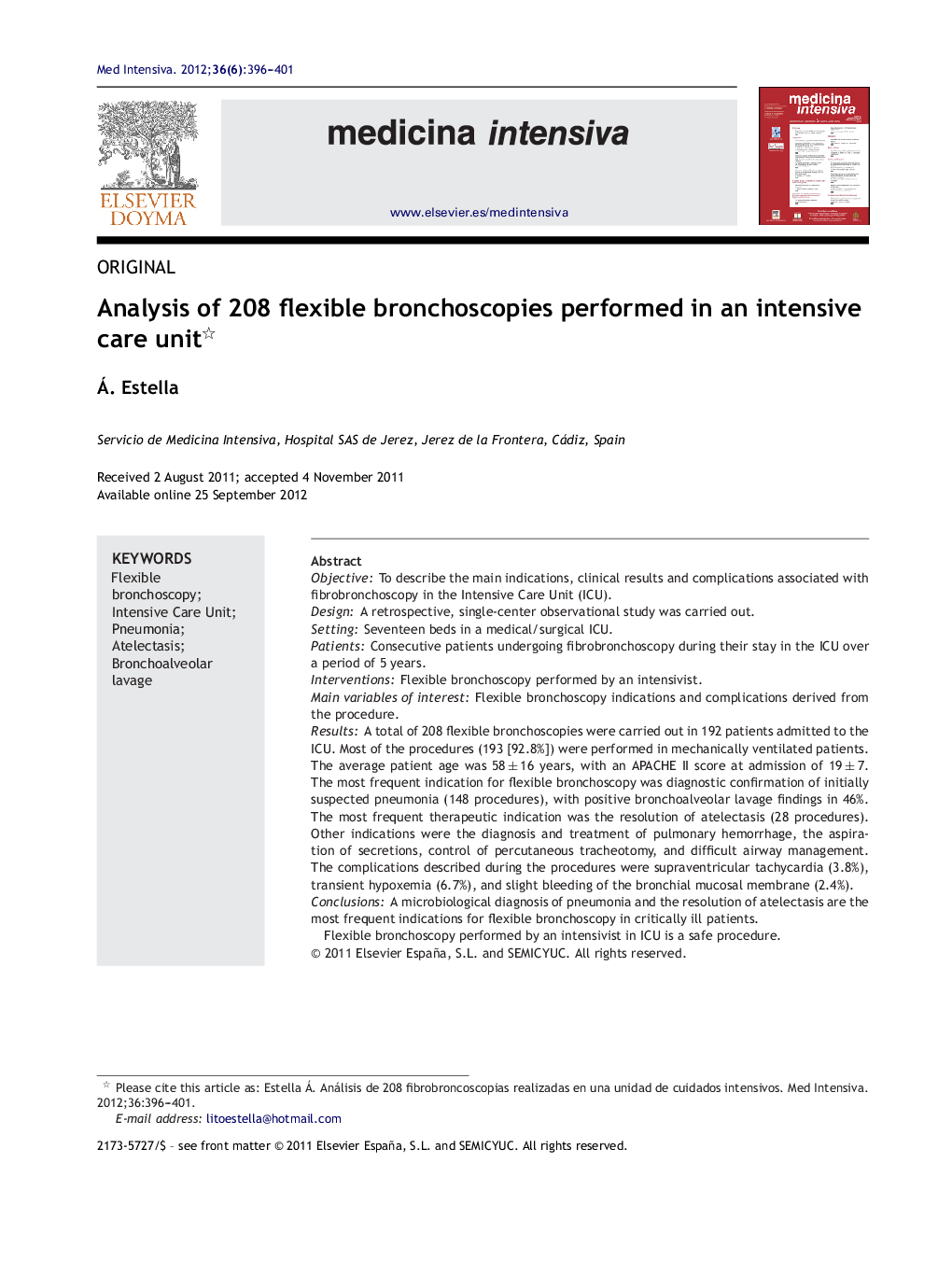| کد مقاله | کد نشریه | سال انتشار | مقاله انگلیسی | نسخه تمام متن |
|---|---|---|---|---|
| 3114263 | 1192507 | 2012 | 6 صفحه PDF | دانلود رایگان |

ObjectiveTo describe the main indications, clinical results and complications associated with fibrobronchoscopy in the Intensive Care Unit (ICU).DesignA retrospective, single-center observational study was carried out.SettingSeventeen beds in a medical/surgical ICU.PatientsConsecutive patients undergoing fibrobronchoscopy during their stay in the ICU over a period of 5 years.InterventionsFlexible bronchoscopy performed by an intensivist.Main variables of interestFlexible bronchoscopy indications and complications derived from the procedure.ResultsA total of 208 flexible bronchoscopies were carried out in 192 patients admitted to the ICU. Most of the procedures (193 [92.8%]) were performed in mechanically ventilated patients. The average patient age was 58 ± 16 years, with an APACHE II score at admission of 19 ± 7. The most frequent indication for flexible bronchoscopy was diagnostic confirmation of initially suspected pneumonia (148 procedures), with positive bronchoalveolar lavage findings in 46%. The most frequent therapeutic indication was the resolution of atelectasis (28 procedures). Other indications were the diagnosis and treatment of pulmonary hemorrhage, the aspiration of secretions, control of percutaneous tracheotomy, and difficult airway management. The complications described during the procedures were supraventricular tachycardia (3.8%), transient hypoxemia (6.7%), and slight bleeding of the bronchial mucosal membrane (2.4%).ConclusionsA microbiological diagnosis of pneumonia and the resolution of atelectasis are the most frequent indications for flexible bronchoscopy in critically ill patients.Flexible bronchoscopy performed by an intensivist in ICU is a safe procedure.
ResumenObjetivoDescribir las principales indicaciones, resultados clínicos y complicaciones de la fibrobroncoscopia en enfermos críticos.DiseñoEstudio retrospectivo, observacional, de un solo centro.ÁmbitoUnidad de Cuidados Intensivos (UCI) médico-quirúrgica de 17 camas.PacientesPacientes consecutivos a los que se les realizó una fibrobroncoscopia durante un periodo de cinco años.IntervencionesFibrobroncoscopia realizada por médicos especialistas en Medicina Intensiva con fines diagnósticos y/o terapéuticos.Principales variables de interésIndicaciones y complicaciones derivadas de la fibrobroncoscopia.ResultadosSe han realizado 208 fibrobroncoscopias en 192 pacientes; en el momento del procedimiento 193 (92,8%) recibían ventilación mecánica invasiva. La edad media de los pacientes incluidos fue de 58 ± 16 años y el APACHE II al ingreso en UCI de 19 ± 7. La mortalidad global fue del 31,3%. Las indicaciones más frecuente fueron en 148 (71,2%) casos por sospecha clínica de neumonía y en 28 (13,5%) para resolución de atelectasias. La fibrobroncospia fue eficaz en 120 (57,7%) casos, con resolución de la atelectasia en 20 casos, 71,4% y obteniendo resultados positivos del LBA en 68 (46%) de los casos con sospecha de neumonía. Se han detectado 27 complicaciones menores en 208 (13%) pacientes. Las complicaciones más frecuentes han sido: taquicardia supraventricular (3,8%), hipoxemia transitoria (6,7%) y hemorragia leve de la mucosa bronquial (2,4%).ConclusionesEl diagnóstico microbiológico de neumonías y la resolución de atelectasias fueron las indicaciones más frecuentes. La fibrobroncoscopia realizada por especialistas de Medicina Intensiva es un procedimiento eficaz y seguro.
Journal: Medicina Intensiva (English Edition) - Volume 36, Issue 6, August–September 2012, Pages 396–401